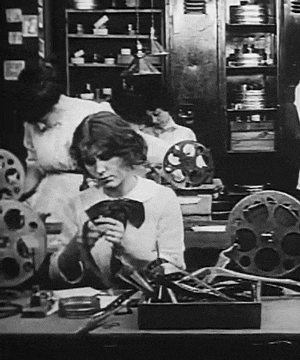From the Editors, May 2018
Peephole Journal was started in 2013 by Whitney Monaghan as a way to think creatively about how we look at, and write about film and screen-based media. The idea was simple – pick a single shot of film and develop a written response to it in 1,000 words. Five years on, Peephole Journal is presenting its tenth issue, and we the editors couldn't be prouder. This milestone has given us a chance to reflect briefly on what Peephole Journal means to us, and why we think our unique format has enabled so many intelligent, surprising and passionate responses over these ten issues.
Our format and name both hark back to Thomas Edison's early cinematic device, the Kinetoscope, in which people had to peep through the viewer to see the short moving images presented. Edison's precursor to cinema was an individual experience; however, in Peephole Journal's contemporary take, we are interested in the relationships between the individual and the collective experiences of contemporary screen media. Peephole Journal is but one contributor to an increasingly diverse and ever-expanding realm of online film criticism and appreciation, expressed through GIFs, blogs, video essays, memes and threads. While it is impossible to generalise the forms and motivations of such examples, one thing that does connect many online forums is an interplay between old and new media, image and text, short and long forms of expression. The online world is replete with examples of users appropriating media forms and finding creative "work-arounds" the limitations and prescribed settings of popular platforms and software.
In restricting our contributors to analysis and discussion of a single shot, Peephole Journal reflects this contemporary condition, considering "constraint[s] as a form of freedom" as our first editorial stated. One of the most pleasing aspects across the last few years has been discovering how flexible this approach actually is. One reason for this connects back to that aforementioned relationship between the individual and the collective, the fragment and the whole. Most forms of screen media are defined, to varying extents, by both duration and narrative. Stories, or successions of images and sounds, unfold over time. And yet, when we think about our favourite or most memorable films or television episodes, we don't tend to recall them in their entirety. We remember fragments. Our memories are composed of snippets, key shots, glances, refrains, one-liners, shifts in focus, light and movement. These fleeting moments linger on long after the episode or film has finished.
Jacques Rancière has spoken about these types of moments and memories as constructing "cinematic fables," as a way of acknowledging that the audience's "perceptions, feelings and words count for as much as the ones printed on the film itself."1 He writes that, as a self-confessed "amateur" film theorist, "I have … retained memories of films, shots and snatches of dialogue that are more or less deformed compared to the original. At various moments I have confronted my memories with the reality of the films, or have reconsidered their interpretation."2 Rancière describes how, over time, he has meandered and returned to his ingrained cinematic memories, in order "to understand why I had been so fascinated by them."3 The power of these moments of course lies in their cinematic form and composition, but also in the personal connections forged through our positions as viewers and fans. As we have seen over the first ten issues of Peephole Journal, these distinctly personal perspectives have often generated the most insightful and creative critical responses.
Here, in our tenth issue, we present ten thoughtful responses to our prompt. Ted Snell, Nick Bugeja and Chris Comerford use "constraint as a form of freedom" to focus on camera movement. Ted considers the languid 89 second opening shot of Luchino Visconti's Death in Venice (1971), Nick writes on Agnès Varda's use of an arc or semicircle shot to frames Cléo in Cléo From 5 to 7 (1962), and Chris considers camera movement in the digital era, reflecting on the use of special effects in the iconic bullet dodge sequence in The Matrix (the Wachowski Siblings, 1999). Both Debbie Zhou and Kenta McGrath turn their attention to reflexive moments in documentaries, which prompt the audience to question the truthfulness of the form. Debbie reflects on key moments in Kirsten Johnson's Cameraperson (2016) while Kenta McGrath discusses Hara Kazuo's The Emperor's Naked Army Marches On (Yuki yukite shingun, 1987).
Writing on two very different films, Jennifer O'Meara and Alexandra Heller-Nicholas explore sisterhood in cinema. Jennifer reflects on food and fashion in on one of our favourite sisterhood films, Romy and Michele's High School Reunion (David Mirkin, 1997) and Alex writes on the most explosive moment in Joël Séria's French exploitation classic Don't Deliver Us From Evil (Mais ne nous délivrez pas du mal, 1971). Finally, three of our essays focus on actors, characters and oppositions. We have Felicity Chaplin on Charlotte Gainsbourg's performance in The Tree (Julie Bertuccelli, 2008), Connie de Silva on the fluidity of Joan Crawford's character Vienna in Johnny Guitar (Nicholas Ray, 1954), and Daniel Hurren on the dichotomies in Jim Jarmusch's Dead Man (1996).
We are particularly pleased to feature this mix of returning contributors and new writers for this special issue.
Whitney, Belinda and Kate

